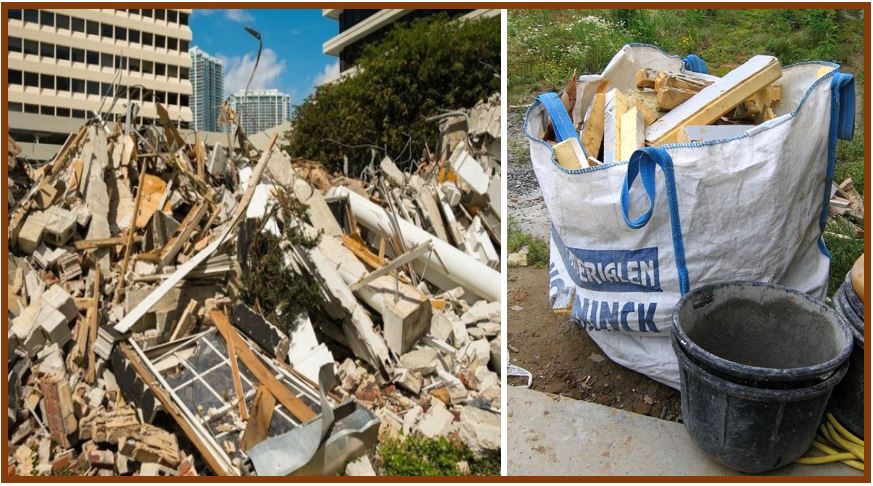This world of ours, sadly, generates at least 3.5 million tons of plastic and other solid waste a day (a day!). This is 10 times more than what we used to create only a century ago. The United States is the king of this “production”. The construction industry creates somewhere around 20 million tons of this waste.
 Typically, this waste includes bricks, metal, asphalt, timber, concrete, plasterboard, rock and soil. And it doesn’t matter which kind of a construction process we are talking about, waste will always occur. Such waste like windows, doors, roofing, lumber and wood products, metals, cardboard, and plastic crates/ containers can be recycled. Everything that can’t be recycled goes to landfills and this is why we should always try to minimize the waste we produce. Most importantly, for that waste we cannot recycle, we need to know how to dispose of it properly so it won’t end up in a landfill.
Typically, this waste includes bricks, metal, asphalt, timber, concrete, plasterboard, rock and soil. And it doesn’t matter which kind of a construction process we are talking about, waste will always occur. Such waste like windows, doors, roofing, lumber and wood products, metals, cardboard, and plastic crates/ containers can be recycled. Everything that can’t be recycled goes to landfills and this is why we should always try to minimize the waste we produce. Most importantly, for that waste we cannot recycle, we need to know how to dispose of it properly so it won’t end up in a landfill.
There are different ways to dispose of waste and many options in the market. For instance, a great alternative out there are the eagle roll-off dumpsters; the company offers same-day pickup services at affordable prices. Not to mention they advise you along the way to properly fulfill your needs.
- We don’t have unlimited space to make those landfills;
- If some of it comes in contact with water, it makes it toxic.
There are several tips you could follow to manage the building waste effectively.
Locate Your Local Recycling Center
Not all cities have recycling centers. You should first ask around about the nearest center and then plan the transport. Gas is not cheap and neither is your vehicle. This is why you should contact a company that can help you dispose of all that building waste.
Integrate the Material Back into the New Building
The smartest way of recycling the building waste is to integrate it back into the new building or that building site you are creating. You don’t have to demolish all the walls; you can just redecorate them, move them, or remodel them.
Build the Building to Standard Dimensions
By building in standard dimensions, you don’t have to cut anything or adapt. It will take less effort and produce less waste. This is also a good idea because it makes it easier to reuse any materials you have leftover.
Don’t Demolish – Deconstruct Instead
By demolishing you destroy everything and lose even the things you could have sold somewhere. Instead of demolishing try deconstructing the building or an object piece by piece. There are certain companies in some areas which remove all the reusable items without any damage and use them in social housing projects. You can also deconstruct the entire object yourself and sell all the items in a front yard sale. Windows, doors, radiators, grates, piping, appliances – they all qualify for these sales.
Complete deconstruction is not always possible, but you can partially deconstruct most buildings. You can easily deconstruct buildings made of wood and the combination of high-quality brick and low-quality mortar but you can salvage the most from structurally sound buildings made of high-quality materials.
You can reuse some materials which include:
- Windows, doors, and roofing material can all be used in some other buildings;
- All the appliances from the building that is being demolished including sinks and baths;
- You can use the largest part of masonry for road bases or during the construction process;
- Metals for the recycling process;
- Lumber and some of the wood products can be used
Separate the Waste Efficiently
One of the ways you can use to lower the waste management cost is proper separation. You can do this by:
- Making a large enough secured waste storage area with clearly marked skips, bags or wheelie bins for different kinds of waste;
- If you can afford it (or you already have it) you can use a mini crusher for all the bricks, blocks, etc.
- All the employees need to be trained in those waste separation procedures and they should be rewarded for the job well done;
The key reason for this separation of construction waste is financial. Nearly a quarter of this waste goes to a landfill and this is an additional expenditure for you and your company. By separating the waste you can use it. The less waste you send to landfill, the higher your profit will be.
*Warning – You need to be careful with any hazardous waste that will be generated by the materials you use. Batteries, all kinds of chemicals, industrial equipment, etc. are all considered dangerous and should be classified as hazards. You should remove such materials with caution and find recycling facilities that are capable of working with such materials.
_________________________________________________________________
Interesting related article: “Disposing of glass waste safely.”

